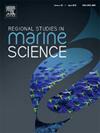A comparative analysis of phytoplankton assemblages in mangrove estuaries of the Persian Gulf and the Sea of Oman
IF 2.1
4区 环境科学与生态学
Q3 ECOLOGY
引用次数: 0
Abstract
This study examined the phytoplankton communities in Iranian mangrove ecosystems along the Persian Gulf and the Sea of Oman in West Asia. Surface water samples were collected from 62 stations distributed across 10 areas within an 1830 km coastal region spanning three southern Iranian provinces: Bushehr, Hormozgan, and Sistan and Baluchestan. Sampling was conducted during November to December 2020. Analysis of these samples identified a diverse community of 169 phytoplankton species, with diatoms (68 %) and dinoflagellates (30 %) being the most abundant groups. Among diatoms, 116 species were identified, belonging to 53 genera. Dinoflagellates included 52 species from 21 genera, with 57 % of these species capable of forming cysts. Rhizosolenia imbricata was the most common diatom species (8 %), while Tripos fusus (26.78 %) and Blixaea quinquecornis (13.26 %) were the dominant dinoflagellates. The highest Shannon diversity index was observed for diatoms (3.283), followed by dinoflagellates (2.482). Eighteen phytoplankton species capable of causing harmful algal blooms were identified in Iranian mangrove forests. DistLM, dbRDA, and marginal tests, applied to investigate environmental factors influencing diatom taxocoenosis composition, indicated temperature as the primary driver, followed by salinity. For dinoflagellates, pH emerged as the primary factor, while temperature and dissolved oxygen played secondary roles. These findings provide valuable information about the composition and distribution of phytoplankton communities in the tropical mangrove forests of Iran, emphasizing the importance of ongoing monitoring.
求助全文
约1分钟内获得全文
求助全文
来源期刊

Regional Studies in Marine Science
Agricultural and Biological Sciences-Ecology, Evolution, Behavior and Systematics
CiteScore
3.90
自引率
4.80%
发文量
336
审稿时长
69 days
期刊介绍:
REGIONAL STUDIES IN MARINE SCIENCE will publish scientifically sound papers on regional aspects of maritime and marine resources in estuaries, coastal zones, continental shelf, the seas and oceans.
 求助内容:
求助内容: 应助结果提醒方式:
应助结果提醒方式:


